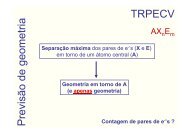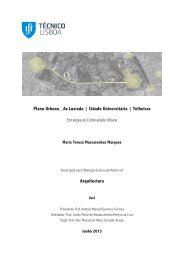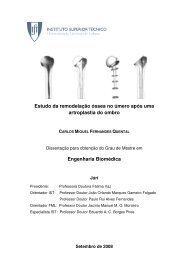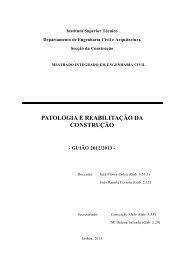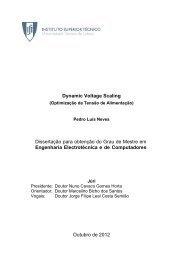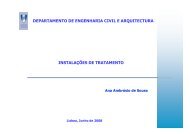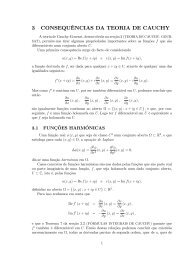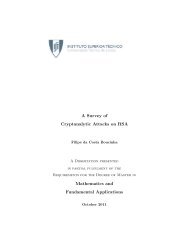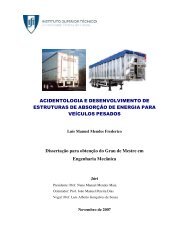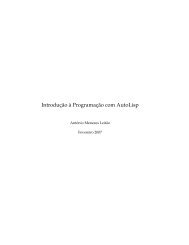Self-Assembly of Large and Small Molecules into Hierarchically ...
Self-Assembly of Large and Small Molecules into Hierarchically ...
Self-Assembly of Large and Small Molecules into Hierarchically ...
You also want an ePaper? Increase the reach of your titles
YUMPU automatically turns print PDFs into web optimized ePapers that Google loves.
<strong>Self</strong>-<strong>Assembly</strong> <strong>of</strong> <strong>Large</strong> <strong>and</strong> <strong>Small</strong> <strong>Molecules</strong> <strong>into</strong><br />
<strong>Hierarchically</strong> Ordered Sacs <strong>and</strong> Membranes<br />
Ramille M. Capito, et al.<br />
Science 319,<br />
1812 (2008);<br />
DOI: 10.1126/science.1154586<br />
The following resources related to this article are available online at<br />
www.sciencemag.org (this information is current as <strong>of</strong> March 28, 2008 ):<br />
Updated information <strong>and</strong> services, including high-resolution figures, can be found in the online<br />
version <strong>of</strong> this article at:<br />
http://www.sciencemag.org/cgi/content/full/319/5871/1812<br />
Supporting Online Material can be found at:<br />
http://www.sciencemag.org/cgi/content/full/319/5871/1812/DC1<br />
This article cites 18 articles,<br />
6 <strong>of</strong> which can be accessed for free:<br />
http://www.sciencemag.org/cgi/content/full/319/5871/1812#otherarticles<br />
This article appears in the following subject collections:<br />
Materials Science<br />
http://www.sciencemag.org/cgi/collection/mat_sci<br />
Information about obtaining reprints <strong>of</strong> this article or about obtaining permission to reproduce<br />
this article in whole or in part can be found at:<br />
http://www.sciencemag.org/about/permissions.dtl<br />
Science (print ISSN 0036-8075; online ISSN 1095-9203) is published weekly, except the last week in December, by the<br />
American Association for the Advancement <strong>of</strong> Science, 1200 New York Avenue NW, Washington, DC 20005. Copyright<br />
2008 by the American Association for the Advancement <strong>of</strong> Science; all rights reserved. The title Science is a<br />
registered trademark <strong>of</strong> AAAS.<br />
on March 28, 2008<br />
www.sciencemag.org<br />
Downloaded from
REPORTS<br />
1812<br />
34. E. Peik et al., http://arxiv.org/abs/physics/0611088v1.<br />
35. We thank C. W. Oates, M. A. Lombardi, <strong>and</strong> D. R. Smith<br />
for comments on the manuscript <strong>and</strong> K. Feder,<br />
J. Nicholson, <strong>and</strong> P. Westbrook for specialty nonlinear<br />
fiber used in the fiber frequency comb. This work was<br />
supported by the Office <strong>of</strong> Naval Research, Disruptive<br />
Technology Office, <strong>and</strong> NIST. P.O.S. acknowledges<br />
support from the Alex<strong>and</strong>er von Humboldt Foundation.<br />
This work is a contribution <strong>of</strong> NIST <strong>and</strong> is not subject to<br />
U.S. copyright.<br />
Supporting Online Material<br />
www.sciencemag.org.cgi/content/full/1154622/DC1<br />
SOM Text<br />
<strong>Self</strong>-<strong>Assembly</strong> <strong>of</strong> <strong>Large</strong> <strong>and</strong> <strong>Small</strong><br />
<strong>Molecules</strong> <strong>into</strong> <strong>Hierarchically</strong> Ordered<br />
Sacs <strong>and</strong> Membranes<br />
Ramille M. Capito, 1 Helena S. Azevedo, 1,2 Yuri S. Velichko, 3 Alvaro Mata, 1 Samuel I. Stupp 1,3,4,5 *<br />
We report here the self-assembly <strong>of</strong> macroscopic sacs <strong>and</strong> membranes at the interface between two<br />
aqueous solutions, one containing a megadalton polymer <strong>and</strong> the other, small self-assembling<br />
molecules bearing opposite charge. The resulting structures have a highly ordered architecture in which<br />
nan<strong>of</strong>iber bundles align <strong>and</strong> reorient by nearly 90° as the membrane grows. The formation <strong>of</strong> a<br />
diffusion barrier upon contact between the two liquids prevents their chaotic mixing. We hypothesize<br />
that growth <strong>of</strong> the membrane is then driven by a dynamic synergy between osmotic pressure <strong>of</strong> ions<br />
<strong>and</strong> static self-assembly. These robust, self-sealing macroscopic structures <strong>of</strong>fer opportunities in<br />
many areas, including the formation <strong>of</strong> privileged environments for cells, immune barriers, new<br />
biological assays, <strong>and</strong> self-assembly <strong>of</strong> ordered thick membranes for diverse applications.<br />
The organization <strong>of</strong> molecules at interfaces<br />
has been a phenomenon <strong>of</strong> great interest<br />
over the past few decades given its importance<br />
in the preparation <strong>of</strong> chemically defined<br />
surfaces <strong>and</strong> ordered materials. One classical<br />
system is the Langmuir-Blodgett film in which<br />
molecules are ordered by compression at an airwater<br />
interface, followed by deposition <strong>of</strong> multilayers<br />
through repeated immersion <strong>of</strong> a solid<br />
substrate <strong>into</strong> the liquid phase (1–3). Another<br />
widely studied system is the self-assembling monolayer<br />
formed at a solid-liquid interface by the<br />
reaction <strong>and</strong> self-ordering <strong>of</strong> dissolved molecules<br />
on a solid surface (4, 5). Other systems include the<br />
formation <strong>of</strong> molecular complexes or solid objects<br />
at the interface <strong>of</strong> two immiscible liquids (6, 7),<br />
<strong>and</strong> electrostatic layer-by-layer deposition <strong>of</strong><br />
amorphous polymers at the solid-liquid interface<br />
through alternation <strong>of</strong> their charge (8).<br />
We report the self-assembly <strong>of</strong> ordered materials<br />
well beyond the monolayer scale at an<br />
aqueous liquid-liquid interface. We combined a<br />
1 to 2 weight (wt) % peptide amphiphile (PA)<br />
solution with a 0.5 to 2 wt% solution <strong>of</strong> the high<br />
molecular weight polysaccharide hyaluronic<br />
acid (HA) (fig. S1A). PAs are small synthetic<br />
1<br />
Institute for BioNanotechnology in Medicine, Northwestern<br />
University, Chicago, IL 60611, USA. 2 3B’s Research Group,<br />
Biomaterials, Biodegradables <strong>and</strong> Biomimetics, Department <strong>of</strong><br />
Polymer Engineering, University <strong>of</strong> Minho, Braga, Portugal.<br />
3<br />
Department <strong>of</strong> Materials Science <strong>and</strong> Engineering, Northwestern<br />
University, Evanston, IL 60208, USA. 4 Department <strong>of</strong><br />
Chemistry, Northwestern University, Evanston, IL 60208, USA.<br />
5<br />
Department <strong>of</strong> Medicine, Northwestern University, Chicago, IL<br />
60611, USA.<br />
*To whom correspondence should be addressed. E-mail:<br />
s-stupp@northwestern.edu<br />
molecules containing typically a hydrophobic<br />
alkyl segment covalently grafted to a short peptide.<br />
The one used here consisted <strong>of</strong> an alkyl<br />
tail <strong>of</strong> 16 carbons attached to the peptide sequence<br />
V 3A 3K 3 (fig. S1B). We previously developed<br />
a broad class <strong>of</strong> PAs that are known to<br />
self-assemble <strong>into</strong> high aspect ratio nan<strong>of</strong>ibers<br />
(9–11). Their tolerance <strong>of</strong> arbitrary domains past<br />
a b-sheet–forming sequence makes them useful<br />
in biological signaling (12, 13). HA is a linear<br />
negatively charged macromolecule containing a<br />
disaccharide repeat unit <strong>of</strong> N-acetylglucosamine<br />
<strong>and</strong> glucuronic acid, present in mammalian extracellular<br />
matrix. When PA <strong>and</strong> HA solutions were<br />
combined in equal volumes, we observed the<br />
immediate formation <strong>of</strong> a solid membrane<br />
localized at the interface between the two liquids.<br />
If the denser HA solution is placed on top<br />
<strong>of</strong> the PA solution, the HA fluid sinks <strong>into</strong> the PA<br />
component, causing renewal <strong>of</strong> the liquid-liquid<br />
interface <strong>and</strong> resulting in continuous growth <strong>of</strong><br />
membrane until the entire volume <strong>of</strong> HA solution<br />
is engulfed (Fig. 1A). This leads to the formation<br />
<strong>of</strong> a polymer-filled sac over periods <strong>of</strong> minutes to<br />
hours depending on the volume <strong>and</strong> density <strong>of</strong> the<br />
liquids used. Alternatively, closed sacs can be<br />
made instantly by injecting one solution directly<br />
<strong>into</strong> the bulk <strong>of</strong> the other, creating either HA-filled<br />
or PA-filled sacs. Other PAs tested led to similar<br />
results without obvious kinetic differences. However,<br />
as expected, the nature <strong>of</strong> the peptide sequence<br />
does affect the structural integrity <strong>of</strong> the<br />
membranes formed.<br />
The instant initiation <strong>of</strong> ordered structures<br />
allows formation <strong>of</strong> self-sealing sacs (Fig. 1, B to<br />
D), films with tailorable size <strong>and</strong> shape (Fig. 1E),<br />
as well as continuous strings (Fig. 1F). Confocal<br />
Figs. S1 <strong>and</strong> S2<br />
References<br />
28 MARCH 2008 VOL 319 SCIENCE www.sciencemag.org<br />
26 December 2007; accepted 20 February 2008<br />
Published online 6 March 2008;<br />
10.1126/science.1154622<br />
Include this information when citing this paper.<br />
microscopy confirmed the incorporation <strong>of</strong> both<br />
HA <strong>and</strong> PA components within the sac membranes(Fig.1,GtoI).<br />
Although formation <strong>of</strong><br />
solids between oppositely charged macromolecules<br />
has been widely demonstrated (14–17),<br />
these systems commonly produce dense <strong>and</strong> disordered<br />
materials that are not permeable to large<br />
molecules (e.g., proteins) <strong>and</strong> are unstable in<br />
water without the use <strong>of</strong> cross-linking chemistry.<br />
Moreover, a large defect such as a hole or a crack<br />
in a solid made up <strong>of</strong> two oppositely charged<br />
polymers cannot be rapidly repaired by diffusion.<br />
The highly ordered materials described<br />
here are mechanically robust in both dry <strong>and</strong> hydrated<br />
states, can be permeable to proteins, <strong>and</strong><br />
have the capability to self-seal defects instantly<br />
by self-assembly.<br />
Recognizing the importance <strong>of</strong> electrostatic<br />
charge screening on the self-assembly <strong>of</strong> PA<br />
nan<strong>of</strong>ibers, we investigated the effect <strong>of</strong> zeta potential<br />
in HA <strong>and</strong> PA solutions on membrane formation<br />
(18). Sac membranes with physical integrity<br />
formed only when both solutions had strong zeta<br />
potentials <strong>of</strong> opposite charge (Fig. 1J). The zeta<br />
potential determines the degree <strong>of</strong> stability <strong>of</strong><br />
charged aggregates in solution, <strong>and</strong> in this case<br />
should correlate to the total electrostatic charge <strong>of</strong><br />
molecules in the presence <strong>of</strong> counterions.<br />
We investigated the microstructure <strong>of</strong> the PA-<br />
HA sac membranes as a function <strong>of</strong> time using<br />
electron microscopy (EM) (18). In the early stages<br />
<strong>of</strong> liquid-liquid contact, scanning electron micrographs<br />
reveal an amorphous layer (Fig. 2, A <strong>and</strong><br />
D, region 1) adjacent to a layer <strong>of</strong> parallel fibers<br />
on the PA solution side (Fig. 2, A <strong>and</strong> D, region<br />
2). We believe that rapid diffusion <strong>of</strong> the small PA<br />
molecules <strong>into</strong> the HA solution <strong>and</strong> electrostatic<br />
complexation <strong>of</strong> both molecules result in the<br />
formation <strong>of</strong> the amorphous zone. The parallel<br />
fiber region, which measures ~150 nm within<br />
1 min <strong>of</strong> contact, is the result <strong>of</strong> self-assembly<br />
triggered by electrostatic screening <strong>of</strong> the amphiphiles<br />
by the negatively charged HA molecules<br />
near the interface. These early events that occur<br />
upon contact between the two liquids establish a<br />
diffusion barrier, which prevents the rapid mixing<br />
<strong>of</strong> the two miscible liquids. Ordered growth <strong>of</strong><br />
nan<strong>of</strong>ibers oriented perpendicular to the interface<br />
then forms a layer that measures ~1.5 mm after 30<br />
min (Fig. 2B, region 3) <strong>and</strong> ~20 mm after 4 days<br />
<strong>of</strong> initial contact (Fig. 2C, region 3).<br />
Transmission electron microscopy (TEM) <strong>of</strong><br />
cross-sectional slices <strong>of</strong> a hydrated membrane<br />
sample(Fig.2,E<strong>and</strong>F)(18) confirmed the morphologies<br />
observed by scanning electron microscopy<br />
(SEM) (Fig. 2D). TEM revealed the presence<br />
<strong>of</strong> the high–molar mass polymer throughout the<br />
on March 28, 2008<br />
www.sciencemag.org<br />
Downloaded from
thickness <strong>of</strong> the membrane (dark regions indicate<br />
positive staining <strong>of</strong> HA by uranyl acetate). The<br />
parallel fiber region between the amorphous layer<br />
<strong>and</strong> the perpendicular fibers is more obvious in<br />
the TEM micrographs (Fig. 2E, region 2). We<br />
calculated the HA density across the membrane<br />
shown in Fig. 2E by image analysis (Fig. 2G).<br />
The density pr<strong>of</strong>ile shows three independent regions:<br />
(1) a region with an approximately constant<br />
polymer density, (2) a region <strong>of</strong> parallel fibers<br />
where there is a maximum in polymer density,<br />
<strong>and</strong> (3) a region <strong>of</strong> perpendicular fibers where the<br />
polymer density decays with increasing distance<br />
from the amorphous region. Most <strong>of</strong> region 1,<br />
where there is constant HA density, is probably<br />
excess HA from the bulk solution that is merged<br />
with a portion <strong>of</strong> the amorphous region <strong>of</strong> the<br />
membrane. The observed accumulation <strong>of</strong> HA<br />
component in the region <strong>of</strong> parallel oriented<br />
nan<strong>of</strong>ibers (Fig. 2E, region 2) suggests a denser<br />
arrangement <strong>of</strong> nanostructures in that zone. We<br />
expect that diffusion <strong>of</strong> both the large <strong>and</strong> small<br />
molecules will eventually slow down as density<br />
increases in the perpendicular fiber region. This<br />
is supported by the decrease in HA density across<br />
the region <strong>of</strong> perpendicular fibers.<br />
The mechanical properties <strong>of</strong> PA-HA membranes<br />
were evaluated by a tensile test (18). The<br />
elastic moduli in the dry <strong>and</strong> hydrated states <strong>of</strong><br />
the membrane were found to be about 670 <strong>and</strong><br />
0.9 MPa, respectively (Fig. 3A). For comparison,<br />
we measured the moduli <strong>of</strong> membranes formed<br />
by the complexation <strong>of</strong> two oppositely charged<br />
polysaccharides, chitosan <strong>and</strong> gellan (both <strong>of</strong> high<br />
molecular weight). The combination <strong>of</strong> these two<br />
polysaccharides has been previously shown to<br />
form macroscopic capsules <strong>and</strong> strings (15, 17),<br />
thus serving as a suitable comparison to our selfassembling<br />
systems. The elastic modulus <strong>of</strong> PA-<br />
HA membranes was found to be about nine times<br />
higher than that <strong>of</strong> the chitosan-gellan membranes<br />
in both hydrated <strong>and</strong> dry states (Fig. 3A).<br />
Despite their lower stiffness, SEM micrographs<br />
<strong>of</strong> the chitosan-gellan membranes (Fig. 3C) showed<br />
a dense structure compared to the PA-HA membrane<br />
(Fig. 3B). Furthermore, the chitosan-gellan<br />
membranes, swollen to about 20 times their original<br />
dry thickness, behave more like hydrogels<br />
<strong>and</strong> fall apart over time when immersed in water.<br />
Hydrated PA-HA membranes, in contrast, exhibit<br />
minimal dimensional change <strong>and</strong> remain very<br />
stable over months in either water or phosphatebuffered<br />
saline. We conclude that hierarchical<br />
order contributes to their greater hydrolytic stability<br />
<strong>and</strong> robust mechanical properties.<br />
We found that it is possible to reseal a macroscopic<br />
hole in a polymer-filled sac. Using a<br />
diacetylene PA molecule (fig. S2) that can be<br />
polymerized after self-assembly to an intense<br />
blue color (19), we were able to create HA-filled<br />
sacs in which a macroscopic defect can be easily<br />
visualized (Fig. 3D). Because the HA component<br />
was contained within the sac, application <strong>of</strong><br />
additional PA solution within the defect space<br />
created a new membrane segment with edges<br />
sufficiently sealed to the original sac membrane<br />
to prevent leakage <strong>of</strong> the fluid inside (Fig. 3E).<br />
Sealing <strong>of</strong> the defect does not require polymerization<br />
<strong>of</strong> the PA molecules. Nonetheless, in this<br />
case, PA molecules in the repaired region were<br />
polymerized to match the appearance <strong>of</strong> the<br />
original sac membrane. Because <strong>of</strong> their robust<br />
character, the PA-HA sacs can also be easily<br />
manipulated <strong>and</strong> sutured (Fig. 3F). When sutured,<br />
the sac can hold its own weight without<br />
further tearing <strong>of</strong> the membrane (Fig. 3G).<br />
A common limitation <strong>of</strong> polyelectrolyte complexes<br />
is lack <strong>of</strong> permeability to larger molecules<br />
such as proteins <strong>and</strong> nucleic acids. We therefore<br />
tested the permeability capabilities <strong>of</strong> the PA-HA<br />
membrane by monitoring diffusion <strong>of</strong> transforminggrowthfactor–b1<br />
(TGF-b1, 25 kD) out <strong>of</strong> a<br />
PA gel-filled sac (18). As a control in this experiment,<br />
a PA gel was created without the surrounding<br />
sac membrane. Sacs enclosing a PA gel <strong>and</strong><br />
TGF-b1 were created by mixing an ~1 wt%<br />
negatively charged PA (fig. S3) <strong>and</strong> TGF-b1(2ng<br />
per sac) with the HA solution before injecting the<br />
mixture <strong>into</strong> the positively charged PA. To sub-<br />
Fig. 1. (A)Schematicrepresentation<br />
<strong>of</strong> one method<br />
to form a self-sealing<br />
closed sac. A sample <strong>of</strong><br />
the denser negatively<br />
charged biopolymer solution<br />
is dropped onto a<br />
positively charged peptide<br />
amphiphile (PA) solution.<br />
(B) Open<strong>and</strong>(C) closed<br />
sac formed by injection <strong>of</strong><br />
a fluorescently tagged<br />
hyaluronic acid (HA) solution<br />
<strong>into</strong> a PA solution.<br />
(D) <strong>Self</strong>-assembled sacs <strong>of</strong><br />
varying sizes. (E) PA-HA<br />
membranes <strong>of</strong> different<br />
shapes created by interfacing<br />
the large- <strong>and</strong><br />
small-molecule solutions<br />
in a very shallow template<br />
(~1 mm thick). (F)Continuous<br />
strings pulled from<br />
the interface between the<br />
PA <strong>and</strong> HA solutions. (G to<br />
I) Confocal microscopy <strong>of</strong><br />
the fluorescein-labeled HA<br />
component (G) <strong>and</strong> the<br />
rhodamine-labeled PA (H)<br />
within the sac membrane.<br />
(I) Merged images demonstrate<br />
colocalization <strong>of</strong> the<br />
PA <strong>and</strong> HA molecules within<br />
the membrane. (J)Zeta<br />
potential measurements <strong>of</strong><br />
HA <strong>and</strong> PA solutions measured<br />
over a wide range<br />
<strong>of</strong> pH values with a qualitative<br />
rating assessing the<br />
ability to form well-defined<br />
sac structures at each pH<br />
condition.<br />
REPORTS<br />
sequently gel the negative PA inside, we placed an<br />
aliquot <strong>of</strong> calcium chloride solution on top <strong>of</strong> the<br />
sac, which penetrates the membrane <strong>and</strong> triggers<br />
self-assembly <strong>of</strong> the negatively charged PA.<br />
Results over a 2-week period revealed similar<br />
TGF-b1 release kinetics between the gels with <strong>and</strong><br />
without the surrounding membrane structure (Fig.<br />
3H), thus confirming the permeability <strong>of</strong> the HA-<br />
PA membrane to proteins.<br />
To investigate if these PA-HA structures can<br />
support cell viability <strong>and</strong> differentiation, we performed<br />
in vitro studies using human mesenchymal<br />
stem cells (hMSCs) (18). Exp<strong>and</strong>ed hMSCs were<br />
incorporated within gel-filled sacs <strong>and</strong> cultured in<br />
growth media, growth media supplemented with<br />
TGF-b1, chondrogenic media, or chondrogenic<br />
media supplemented with TGF-b1. The hMSCs<br />
remained viable within the sacs (Fig. 3I) for up<br />
to 4 weeks in culture. Furthermore, results obtained<br />
with real-time reverse transcription polymerase<br />
chain reaction after 2 weeks in culture<br />
(Fig. 3J) revealed an increase in collagen type II<br />
gene expression when cells in sacs were stimulated<br />
with TGF or chondrogenic media, indi-<br />
www.sciencemag.org SCIENCE VOL 319 28 MARCH 2008 1813<br />
on March 28, 2008<br />
www.sciencemag.org<br />
Downloaded from
REPORTS<br />
1814<br />
cating that hMSCs were able to differentiate<br />
toward a chondrogenic phenotype within the<br />
sacs. The self-assembling sacs could therefore<br />
provide sufficient nutrient diffusion necessary for<br />
cell survival <strong>and</strong> differentiation.<br />
We have formulated a possible mechanism<br />
for the self-assembly <strong>of</strong> these hierarchically ordered<br />
structures. Upon liquid-liquid contact, we<br />
first expect rapid mixing by diffusion <strong>of</strong> molecules<br />
localized at the interface (Fig. 4A), with<br />
the small molecules diffusing readily <strong>into</strong> the<br />
polymer solution <strong>and</strong> leading to electrostatic complexation.<br />
Ionic screening along the entire contact<br />
area leads simultaneously to self-assembly <strong>of</strong><br />
PA nan<strong>of</strong>ibers localized at the interface (Fig. 4B).<br />
This creates a diffusion barrier for long entangled<br />
HA chains <strong>and</strong> PA molecules or their aggregates,<br />
resulting in the physical separation <strong>of</strong> both components.<br />
Subsequent growth <strong>of</strong> fibers oriented<br />
perpendicular to the interface occurs toward the<br />
PA side as indicated by electron microscopy. This<br />
suggests that the megadalton macromolecules<br />
diffuse <strong>into</strong> the small-molecule solution. At first<br />
glance this is counterintuitive because one might<br />
expect the small molecules to diffuse more<br />
rapidly <strong>into</strong> the polymer solution. Diffusion <strong>of</strong><br />
the large macromolecules <strong>into</strong> the PA solution,<br />
however, can be driven by the osmotic pressure<br />
imbalance between the PA <strong>and</strong> HA solutions.<br />
This imbalance is primarily due to the preservation<br />
<strong>of</strong> macroscopic electroneutrality; because <strong>of</strong><br />
the greater charge density in a high molecular<br />
weight polyelectrolyte, a greater number <strong>of</strong> ions<br />
are required to neutralize the total charge in the<br />
HA solution compared to the PA solution. This<br />
difference in ion concentration results in an excess<br />
osmotic pressure <strong>of</strong> ions in the HA compartment,<br />
resulting in reptation <strong>of</strong> macromolecules<br />
through the diffusion barrier. These macromolecules<br />
entering the PA side could then nucleate<br />
PA nan<strong>of</strong>ibers perpendicular to the contact interface<br />
(Fig. 4C).<br />
By applying Poisson-Boltzman theories to<br />
the cell model <strong>of</strong> polyelectrolytes (20, 21), one<br />
can describe the difference in osmotic pressure<br />
DP between the two solutions by the expression<br />
DP ≡ PHA − PPA ¼ kBT X<br />
0<br />
1<br />
eniyðRÞ<br />
−<br />
B<br />
ni e kBT C<br />
@ − 1A<br />
where ni <strong>and</strong> ni are the concentration <strong>and</strong> valence<br />
<strong>of</strong> mobile ions, yðRÞ is a local electrostatic<br />
potential, R is the Wigner cell radius, kB is the<br />
Bolzmann constant, <strong>and</strong> T is the temperature<br />
(20). The electrostatic potential is proportional to<br />
the measured zeta potential, z, in our earlier experiments<br />
<strong>and</strong> has a direct effect on the osmotic<br />
pressure difference as follows:<br />
DP e z 2X<br />
i<br />
i<br />
niðeniÞ 2<br />
2kBT<br />
≥ 0<br />
Therefore, a substantial difference in zeta potential<br />
between the two components will result in a<br />
large difference in osmotic pressure. Under excess<br />
osmotic pressure in the HA compartment,<br />
macromolecules will preferentially diffuse through<br />
the initially formed contact layer. The required<br />
elongated conformation <strong>of</strong> the HA molecule for<br />
diffusion through the pores <strong>of</strong> the contact layer<br />
also creates an entropic barrier that can be overcome<br />
only when the excess osmotic pressure<br />
dominates. The diffusion driven by the excess<br />
osmotic pressure, DP, can be described by the<br />
Smoluchowski equation<br />
∂<br />
∂<br />
wðs; tÞ ¼Do<br />
∂t ∂s<br />
∂<br />
∂s þ DPlb2 − F<br />
kBT<br />
wðs; tÞ<br />
where Do is the bare diffusion coefficient, l is<br />
the thickness <strong>of</strong> the diffusive barrier, b is the HA<br />
monomer size, FºkBTlnðN − sÞ is the entropic<br />
free energy <strong>of</strong> a polymer chain <strong>of</strong> N repeats with<br />
s monomer units that have passed through the<br />
membrane, <strong>and</strong> wðs; tÞ determines the probability<br />
<strong>of</strong> having a segment <strong>of</strong> s monomers at<br />
time t through the membrane. The released free<br />
ends <strong>of</strong> HA molecules, after complete reptation<br />
through the contact layer, produce polymer “stubs”<br />
at the surface <strong>of</strong> the contact layer (Fig. 4D) that<br />
attract the oppositely charged PA molecules<br />
(Fig. 4B) <strong>and</strong> nucleate the self-assembly <strong>of</strong><br />
perpendicularly oriented nan<strong>of</strong>ibers through<br />
electrostatic screening (Fig. 4C). Growth <strong>of</strong> the<br />
nan<strong>of</strong>ibers would then occur by attraction <strong>of</strong> PA<br />
aggregates at the base <strong>of</strong> the polymer stubs as<br />
“new” HA segments continue to penetrate through<br />
the parallel fiber mesh (Fig. 4, C <strong>and</strong> E). <strong>Self</strong>assembly<br />
<strong>of</strong> the hybrid nan<strong>of</strong>ibers should release<br />
condensed counterions that subsequently migrate<br />
to the polymer side, given the high affinity <strong>of</strong><br />
polyelectrolytes for small ions. Hence, the excess<br />
osmotic pressure difference can be sustained in a<br />
dynamic fashion to continuously pump additional<br />
polymer chains through the barrier. One would<br />
expect that extensive self-assembly <strong>and</strong> elongation<br />
<strong>of</strong> these fibers would lead to a crowding effect that<br />
further increases the orientational order or align-<br />
Fig. 2. (A to C) SEM <strong>of</strong> the sac membrane as it forms over time (HA solution side on top, PA<br />
solution side on bottom): (A) 1 min, (B) 30 min, <strong>and</strong> (C) 4 days. TEM <strong>of</strong> a cross-sectional slice <strong>of</strong> the<br />
membrane (E <strong>and</strong> F) show morphologies similar to those observed in SEM (D), particularly the<br />
perpendicularly oriented nan<strong>of</strong>ibers (F, arrows). The parallel fiber region (arrow) between the<br />
amorphous <strong>and</strong> perpendicular fiber zones is most obvious in TEM (E, region 2). Dark regions<br />
indicate positive staining <strong>of</strong> HA by uranyl acetate. (G) Polymer density pr<strong>of</strong>ile obtained by image<br />
analysis <strong>of</strong> (E) quantifying the density <strong>of</strong> dark regions across the membrane.<br />
28 MARCH 2008 VOL 319 SCIENCE www.sciencemag.org<br />
on March 28, 2008<br />
www.sciencemag.org<br />
Downloaded from
Fig. 3. (A) Tensile test data comparing the elastic modulus<br />
<strong>of</strong> the self-assembled membrane to an amorphous<br />
membrane composed <strong>of</strong> chitosan <strong>and</strong> gellan in both the<br />
dry <strong>and</strong> hydrated states. (B <strong>and</strong> C) SEM showing the cross<br />
sections <strong>of</strong> (B) the hierarchically ordered membrane <strong>and</strong><br />
(C) the amorphous polymer-polymer membrane [the<br />
striations in (C) are effects from slicing the dense membrane<br />
during sample preparation]. (D) <strong>Hierarchically</strong> ordered<br />
sac formed with polydiacetylene PA containing a<br />
macroscopic defect within the membrane (arrow). (E)Sac<br />
in (D) after the defect is repaired <strong>and</strong> the sac resealed by<br />
triggering additional self-assembly with a drop <strong>of</strong> PA<br />
(arrow). Sacs are robust enough to withst<strong>and</strong> suturing (F)<br />
<strong>and</strong> can hold their weight without further tearing <strong>of</strong> the<br />
membrane (G). (H)TGF-b1 release from PA gel-filled sacs<br />
<strong>and</strong>PAgelsasafunction<strong>of</strong>time,demonstratinganearly<br />
identical protein-release pr<strong>of</strong>ile. (I) Live/dead assay <strong>of</strong><br />
hMSCs cultured within the PA gel-filled sacs (green cells<br />
are live, red cells are dead) showing that most <strong>of</strong> the cells<br />
remain viable. (J) Collagen type II gene expression <strong>of</strong><br />
hMSCs cultured within the PA gel–filled sacs in growth<br />
medium (GM), growth medium supplemented with TGF-b1<br />
(TGF-GM), chondrogenic medium (CM), <strong>and</strong> chondrogenic<br />
medium supplemented with TGF-b1 (TGF-CM). Error bars<br />
in (A), (H), <strong>and</strong> (J) denote SD.<br />
Fig. 4. (A to F)Schematic<br />
illustration <strong>of</strong> the proposed<br />
model for ordered PA-HA<br />
membrane formation. (A)<br />
Initial mixing <strong>of</strong> the large<br />
<strong>and</strong> small molecules at the<br />
interface. (B) Formation <strong>of</strong><br />
nan<strong>of</strong>ibers at the interface<br />
composed <strong>of</strong> small molecules<br />
(due to electrostatic<br />
screening by the negatively<br />
charged polymer) creates<br />
a physical barrier between<br />
the two solutions. This is<br />
followed by reptation <strong>of</strong><br />
macromolecules through<br />
the barrier <strong>and</strong> <strong>into</strong> the<br />
small-molecule solution<br />
(yellow arrow). (C) Nucleation<br />
<strong>of</strong> nan<strong>of</strong>ibers perpendicular<br />
to the interface by<br />
polymer str<strong>and</strong>s crossing<br />
the barrier (yellow arrow).<br />
Pink arrows indicate attraction<br />
<strong>of</strong> PA monomer or<br />
their aggregates to polymer str<strong>and</strong>s as they continue to cross the barrier.<br />
(D) Schematic representation <strong>of</strong> polymer stubs (red) penetrating the<br />
diffusion barrier. (E) Subsequent self-assembly <strong>of</strong> nan<strong>of</strong>ibers (blue) initiated<br />
by the stubs. These nan<strong>of</strong>ibers start gaining orientation perpen-<br />
REPORTS<br />
dicular to the interface as polymer diffuses further <strong>into</strong> the smallmolecule<br />
solution. (F) Growth <strong>of</strong> the nan<strong>of</strong>ibers perpendicular to the<br />
interface over time, becoming denser <strong>and</strong> increasingly aligned as the<br />
membrane thickens.<br />
www.sciencemag.org SCIENCE VOL 319 28 MARCH 2008 1815<br />
on March 28, 2008<br />
www.sciencemag.org<br />
Downloaded from
REPORTS<br />
1816<br />
ment in this region over time (Fig. 4F), as demonstrated<br />
earlier by microscopy (Fig. 2C).<br />
The synergistic interaction between large <strong>and</strong><br />
self-assembling small molecules with both static<br />
<strong>and</strong> dynamic components has great potential for<br />
the discovery <strong>of</strong> highly functional materials. The<br />
sacs formed by these self-assembling systems<br />
could be attractive controlled environments for<br />
cells in assays or therapies. Moreover, ordered<br />
thick membranes could be molecularly customized<br />
to possess desired physical or bioactive<br />
functions. An interesting possibility is to design<br />
similar systems in organic solvents for nonbiological<br />
applications.<br />
References <strong>and</strong> Notes<br />
1. K. B. Blodgett, J. Am. Chem. Soc. 57, 1007(1935).<br />
2. H. Ringsdorf, B. Schlarb, J. Venzmer, Angew. Chem. Int.<br />
Ed. Engl. 27, 114 (1988).<br />
3. J. A. Zasadzinski, R. Viswanathan, L. Madsen, J. Garnaes,<br />
D. K. Schwartz, Science 263, 1726 (1994).<br />
4. C. D. Bain et al., J. Am. Chem. Soc. 111, 321 (1989).<br />
5. G. M. Whitesides, P. E. Laibinis, Langmuir 6, 87 (1990).<br />
6. L. Pirondini et al., Proc. Natl. Acad. Sci. U.S.A. 99, 4911<br />
(2002).<br />
7. N. Bowden, A. Terfort, J. Carbeck, G. M. Whitesides,<br />
Science 276, 233 (1997).<br />
8. G. Decher, Science 277, 1232 (1997).<br />
9. J. D. Hartgerink, E. Beniash, S. I. Stupp, Science 294,<br />
1684 (2001).<br />
10. H. A. Behanna, J. J. J. M. Donners, A. C. Gordon,<br />
S. I. Stupp, J. Am. Chem. Soc. 127, 1193 (2005).<br />
11. K. Rajangam et al., Nano Lett. 6, 2086 (2006).<br />
12. G. A. Silva et al., Science 303, 1352 (2004).<br />
13. H. Storrie et al., Biomaterials 28, 4608 (2007).<br />
14. S. Wen, Y. Xiaonan, W. T. K. Stevenson, Biomaterials 12,<br />
374 (1991).<br />
15. H. Yamamoto, Y. Senoo, Macromol. Chem. Phys. 201, 84<br />
(2000).<br />
16. H. Yamamoto, C. Horita, Y. Senoo, A. Nishida, K. Ohkawa,<br />
J. Appl. Polym. Sci. 79, 437 (2001).<br />
17. K. Ohkawa, T. Kitagawa, H. Yamamoto, Macromol. Mater.<br />
Eng. 289, 33 (2004).<br />
18. Materials <strong>and</strong> methods are available as supporting<br />
material on Science Online.<br />
The Transition from Stiff to<br />
Compliant Materials in Squid Beaks<br />
Ali Miserez, 1,2,3 Todd Schneberk, 2,3 Chengjun Sun, 2,3 Frank W. Zok, 1 * J. Herbert Waite 2,3 *<br />
The beak <strong>of</strong> the Humboldt squid Dosidicus gigas represents one <strong>of</strong> the hardest <strong>and</strong> stiffest<br />
wholly organic materials known. As it is deeply embedded within the s<strong>of</strong>t buccal envelope,<br />
the manner in which impact forces are transmitted between beak <strong>and</strong> envelope is a matter <strong>of</strong><br />
considerable scientific interest. Here, we show that the hydrated beak exhibits a large stiffness<br />
gradient, spanning two orders <strong>of</strong> magnitude from the tip to the base. This gradient is correlated<br />
with a chemical gradient involving mixtures <strong>of</strong> chitin, water, <strong>and</strong> His-rich proteins that contain<br />
3,4-dihydroxyphenyl-L-alanine (dopa) <strong>and</strong> undergo extensive stabilization by histidyl-dopa<br />
cross-link formation. These findings may serve as a foundation for identifying design principles for<br />
attaching mechanically mismatched materials in engineering <strong>and</strong> biological applications.<br />
Living organisms are functional assemblages<br />
<strong>of</strong> different interconnected tissues. Not infrequently,<br />
tissues with highly disparate mechanical<br />
properties (e.g., bone <strong>and</strong> cartilage, shell<br />
<strong>and</strong> adductor muscle, nail <strong>and</strong> skin) are joined<br />
together (1). In practice, the joining <strong>of</strong> dissimilar<br />
materials can lead to high interfacial stresses <strong>and</strong><br />
contact damage (2, 3). In apparent contradiction<br />
to this, the contacts between mechanically mismatched<br />
biomolecular tissues are remarkably robust.<br />
Mechanical-property gradients are increasingly<br />
invoked as the principal reason for their mechanical<br />
performance. The dentino-enamel junction<br />
(4), arthropod exoskeleton (5), polychaete jaws,<br />
<strong>and</strong> mussel byssal threads (6) all exhibit such<br />
gradients. Optical properties in squid eyes have<br />
also been correlated to a protein-density gradient<br />
1<br />
Materials Department, University <strong>of</strong> California, Santa Barbara,<br />
CA 93106, USA. 2 Department <strong>of</strong> Molecular, Cellular, <strong>and</strong> Developmental<br />
Biology, University <strong>of</strong> California, Santa Barbara, CA<br />
93106, USA. 3 Marine Science Institute, University <strong>of</strong> California,<br />
Santa Barbara, CA 93106, USA.<br />
*To whom correspondence should be addressed. E-mail:<br />
zok@engineering.ucsb.edu (F.W.Z.); waite@lifesci.ucsb.<br />
edu (J.H.W.)<br />
(7). Although much is known about the mechanical<br />
<strong>and</strong> biochemical properties <strong>of</strong> the separate<br />
tissues, surprisingly little has been done to<br />
explain how mixtures <strong>of</strong> macromolecules are<br />
adapted for incremental mechanical effects at<br />
interfaces.<br />
The beak <strong>of</strong> the Humboldt squid Dosidicus<br />
gigas is an example <strong>of</strong> a system with grossly mismatched<br />
tissues. It is composed <strong>of</strong> slightly <strong>of</strong>fset<br />
apposing upper <strong>and</strong> lower parts that make no hard<br />
pivotal contact with one another <strong>and</strong> are set <strong>into</strong> a<br />
muscular buccal mass that controls their movement<br />
(8). The beak tip (or rostrum) is among the<br />
hardest <strong>and</strong> stiffest <strong>of</strong> wholly organic biomaterials<br />
(9). With a single notch through the thick dorsal<br />
integument <strong>of</strong> a captured fish, a squid beak can<br />
sever the nerve cord to paralyze prey for later<br />
leisurely dining (10). The predatory activity <strong>of</strong> a<br />
stiff razor-sharp beak embedded in a s<strong>of</strong>ter muscle<br />
mass might be compared to a person carving a<br />
roast with a bare metal blade. In both scenarios,<br />
there would be as much damage to self as to the<br />
intended objects. We found that the squid’s task<br />
is facilitated by a beak design that incorporates<br />
large gradients in mechanical properties, intricately<br />
28 MARCH 2008 VOL 319 SCIENCE www.sciencemag.org<br />
19. L. Hsu, G. L. Cvetanovich, S. I. Stupp, J. Am. Chem. Soc.<br />
10.1021/ja076553s (2008).<br />
20. M. Deserno, H. H. von Grunberg, Phys. Rev. E Stat.<br />
Nonlin. S<strong>of</strong>t Matter Phys. 66, 011401 (2002).<br />
21. C. Holm, P. Kékicheff, R. Podgornik, Electrostatic Effects<br />
in S<strong>of</strong>t Matter <strong>and</strong> Biophysics (NATO Science Series II,<br />
Kluwer, Dordrecht, Netherl<strong>and</strong>s, 2001), pp. 27–52.<br />
22. Supported by the U.S. Department <strong>of</strong> Energy (grant<br />
DE-FG02-00ER45810), the NIH (grants 5-R01-<br />
EB003806, 5-R01-DE015920, <strong>and</strong> 5-P50-NS054287),<br />
<strong>and</strong> the NSF (grant DMR-0605427). We thank N. A. Shah<br />
for the suturing tests, L. Hsu for synthesis <strong>of</strong> the<br />
diacetylene peptide amphiphile, R. Walsh for processing<br />
TEM samples, the Brinson laboratory at Northwestern<br />
University for assistance with mechanical testing, <strong>and</strong><br />
M. Seniw for assistance with illustrations.<br />
Supporting Online Material<br />
www.sciencemag.org/cgi/content/full/319/5871/1812/DC1<br />
Materials <strong>and</strong> Methods<br />
Figs. S1 to S3<br />
26 December 2007; accepted 7 February 2008<br />
10.1126/science.1154586<br />
linked with local macromolecular composition,<br />
from the hard, stiff tip to the s<strong>of</strong>t, compliant base.<br />
When detached from the buccal mass, each<br />
Humboldt squid beak exhibits clearly visible gradients<br />
in pigmentation, ranging from translucent<br />
along the wing edge to black at the beak tip (Fig.<br />
1, B <strong>and</strong> C). The pigmentation gradient appears<br />
to be closely coupled to a distribution <strong>of</strong> catechols<br />
that correspond to proteins containing 3,4dihydroxyphenyl-L-alanine<br />
(dopa) (9). Catechol<br />
staining (red in Fig. 1D) is evident in the lightly<br />
tanned regions <strong>and</strong> more intensely (though largely<br />
obscured by black pigment) in the heavily<br />
tanned regions. Because the beaks are large<br />
enough to allow cutout specimens showing incremental<br />
differences in pigmentation (Fig. 1E),<br />
we performed coupled chemical <strong>and</strong> mechanical<br />
analyses to explore the consequences <strong>of</strong> pigmentation<br />
(figs. S1 <strong>and</strong> S2).<br />
We carried out chemical analyses <strong>of</strong> consecutive<br />
cutouts after degradation by two treatments<br />
that preferentially attack different structural components:<br />
acid hydrolysis, which hydrolyzes<br />
protein <strong>and</strong> chitin but not the tanning pigment,<br />
<strong>and</strong> alkaline peroxidation, which solubilizes<br />
everything but chitin (see flowchart in fig. S1).<br />
The hydrolyzed untanned material is dominated<br />
by glucosamine, the basic structural unit <strong>of</strong> chitin<br />
[Fig. 2A(i)], whose presence was independently<br />
established by fiber x-ray diffraction (9). On the<br />
basis <strong>of</strong> glucosamine detection, chitin content in<br />
this region is estimated to be 90% <strong>of</strong> dry weight,<br />
compared to a low <strong>of</strong> 15 to 20% in the rostrum<br />
[Fig. 2A(ii)]. The amino acid composition <strong>of</strong><br />
hydrolysates from all tanned regions is uniform<br />
<strong>and</strong> dominated by Gly, Ala, His <strong>and</strong> Asx (where<br />
Asx represents Asp <strong>and</strong> Asn combined) (27, 15,<br />
11, <strong>and</strong> 7 mole percent, respectively) (Fig. 2, A<br />
<strong>and</strong> B). Only the untanned region differed in<br />
composition, with the Asx content being considerably<br />
higher <strong>and</strong> that <strong>of</strong> the other amino acids<br />
being somewhat lower than the corresponding<br />
values in the tanned regions. This disparity may<br />
on March 28, 2008<br />
www.sciencemag.org<br />
Downloaded from



